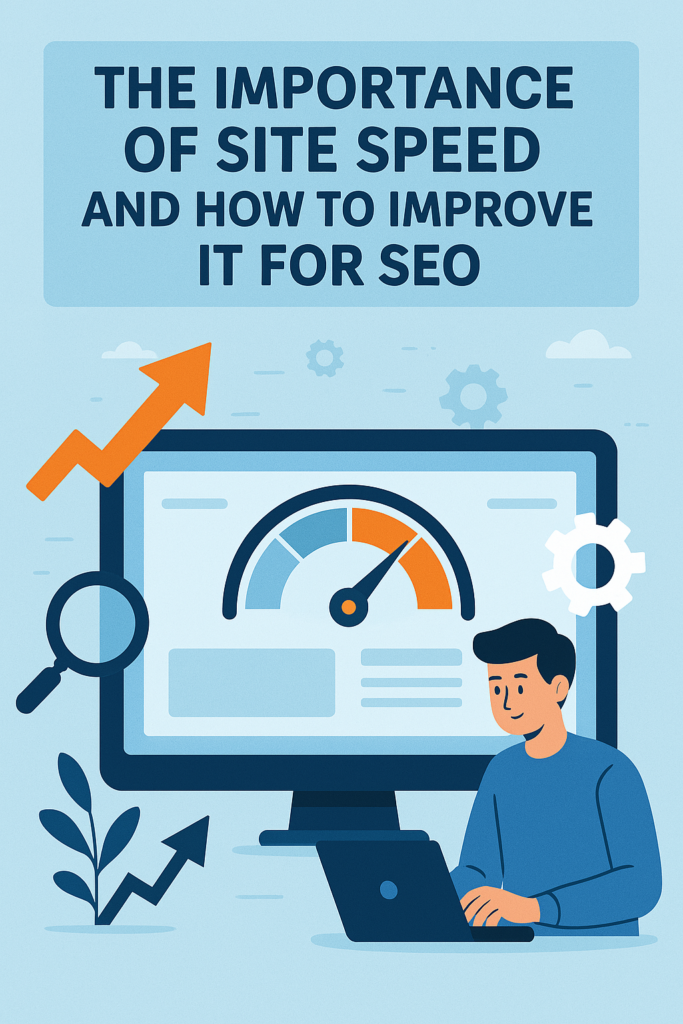
The Importance of Site Speed and How to Improve It for SEO Site speed plays a vital role in both user experience and SEO performance. A faster website ensures that visitors can access content quickly, leading to higher engagement and lower bounce rates. Search engines like Google prioritize fast-loading sites in their rankings, as speed is a key factor in delivering quality experiences. Slow-loading websites can frustrate users, leading to decreased traffic, conversions, and potential loss of customers. Improving site speed not only boosts SEO but also helps maintain a positive reputation and enhances overall website performance.
In the digital age, website speed plays a crucial role in determining the success of your online presence. Search engines, particularly Google, prioritize user experience, and slow-loading websites can directly impact your rankings. Studies show that even a one-second delay in load time can lead to a significant drop in conversions and user engagement. Furthermore, Google has explicitly stated that site speed is a ranking factor, meaning that faster websites are more likely to rank higher in search engine results pages (SERPs). A faster website not only improves SEO performance but also helps in retaining visitors, thereby reducing bounce rates.
To enhance your site’s speed, there are several technical aspects you should consider. One of the most effective ways to boost speed is by optimizing images. Large, uncompressed images can significantly slow down your site, so ensuring that images are the correct size and format can have a noticeable impact. Additionally, leveraging browser caching and enabling compression can help reduce load times. By storing elements of your site locally in a user’s browser, you can make repeat visits faster. It’s also essential to choose a reliable web hosting provider, as server performance directly affects how quickly your pages load.
Another powerful strategy for improving site speed is minimizing JavaScript and CSS files. Unnecessary code can increase load times, so minimizing or consolidating files helps streamline page performance. Additionally, using content delivery networks (CDNs) can distribute content across multiple servers around the world, making it faster for users from different regions to access your site. Regularly testing and monitoring your website’s speed through tools like Google PageSpeed Insights or GTmetrix will help identify areas that need improvement. By implementing these practices, you can significantly boost your site’s speed, improve your user experience, and enhance your SEO ranking.
4 Key Points to Improve Website Speed for Better SEO
- Optimize Images for Faster Load Times Large and unoptimized images are one of the primary reasons for slow websites. Images that aren’t compressed or resized to fit the necessary dimensions can drastically slow down your page load time. Optimizing images by reducing file sizes without compromising quality can improve site speed significantly. Tools like Adobe Photoshop, TinyPNG, or plugins for content management systems (CMS) like WordPress can automatically compress images, ensuring they load quickly. Additionally, consider using modern image formats such as WebP, which offer high-quality images at smaller file sizes.
- Leverage Browser Caching to Improve Load Times Browser caching allows your website’s resources (like images, CSS files, and JavaScript) to be stored on a user’s device after their first visit. This means that when they return to your website, the browser can quickly load these resources from the local cache, speeding up the overall load time. To enable caching, you can adjust cache settings in your server or use a caching plugin if you’re using a CMS like WordPress. By reducing the need for the browser to reload static content, you’ll enhance user experience and improve SEO rankings due to faster load times.
- Minimize JavaScript and CSS Files Excessive or bloated JavaScript and CSS files can slow down page load speeds, as browsers need to load and render these files before displaying your content. To address this, you can minify and combine JavaScript and CSS files to remove unnecessary characters, such as spaces and comments, and combine multiple files into one. This reduces the number of HTTP requests, making your website load faster. Tools like UglifyJS, CSSNano, and online minification tools can help you streamline these files. By optimizing these elements, your site will load faster, contributing to improved SEO.
- Use a Content Delivery Network (CDN) A Content Delivery Network (CDN) is a network of servers distributed globally that deliver your website’s content to users based on their geographic location. By using a CDN, you ensure that users from various regions experience faster load times since the content is served from a server that’s closer to them. This reduces latency and ensures consistent, fast delivery of static content like images, scripts, and stylesheets. Implementing a CDN is especially beneficial for websites with a global audience and can result in improved site performance and better SEO outcomes, as Google rewards faster, user-friendly websites in its rankings.
By implementing these four strategies—optimizing images, leveraging browser caching, minimizing JavaScript/CSS, and using a CDN—you can significantly enhance your website’s speed, providing both a better user experience and a better chance to rank higher in search engine results.

Site speed is a critical factor when it comes to both user experience and SEO. A slow website can lead to higher bounce rates, lower engagement, and a drop in conversions, all of which negatively affect your search engine ranking. Google, for instance, uses site speed as one of its ranking factors, meaning that faster websites are more likely to rank higher in search results. Moreover, as user expectations increase, they are less likely to wait around for a slow website to load. By improving site speed, you can not only enhance the user experience but also improve your chances of ranking higher on search engines, leading to more organic traffic and better overall website performance.
One of the key benefits of improving site speed is the reduction in bounce rates. When users land on a page and it takes too long to load, they’re more likely to leave before even viewing the content. Faster load times, on the other hand, keep users engaged and encourage them to explore more pages on your site. This increased engagement can have a positive impact on SEO, as search engines reward websites that provide a positive user experience. Additionally, optimizing images and leveraging browser caching can significantly improve the speed of your site, allowing you to retain visitors and reduce the likelihood of them abandoning your site prematurely.
Improving site speed also positively impacts your mobile users. With mobile traffic accounting for a significant portion of internet usage, ensuring your website loads quickly on mobile devices is crucial. Websites that load slowly on mobile devices can lead to poor user experiences and reduced mobile rankings. By focusing on key aspects like image optimization, enabling compression, and choosing a reliable hosting provider, you can create a fast, mobile-friendly experience. The combined benefits of faster load times, reduced bounce rates, and improved SEO rankings make site speed a top priority for anyone looking to optimize their website’s performance and overall success.
At Prom Marketing, we specialize in providing comprehensive SEO services designed to enhance your online visibility and drive organic traffic to your website. Whether you’re a small business looking to improve your local SEO or a large enterprise aiming for global reach, our team of SEO experts is equipped with the latest strategies and tools to help you rank higher on search engine results pages (SERPs). From keyword research and on-page optimization to building high-quality backlinks and improving site speed, we offer a holistic approach to SEO that focuses on delivering long-term results. By partnering with Prom Marketing, you’ll not only see improvements in your search rankings but also in your website’s overall user experience, which is key to converting visitors into loyal customers. Let us help you unlock the full potential of your online presence with our tailored SEO services, driving more traffic, more leads, and ultimately, more sales.
SEO (Search Engine Optimization) is a powerful digital marketing tool that provides several advantages for businesses looking to improve their online presence. One of the key benefits of SEO is increased visibility. By optimizing your website with relevant keywords and quality content, you can rank higher on search engine results pages (SERPs), making it easier for potential customers to find you. The higher your ranking, the more likely people will click on your website, driving more organic traffic without having to pay for advertisements.
Another significant advantage of SEO is its cost-effectiveness. Unlike paid advertising, SEO focuses on long-term results, offering a high return on investment (ROI) over time. By investing in good SEO practices, businesses can reduce their dependency on paid ads and achieve sustainable growth. SEO helps you create content that attracts the right audience, which means you don’t have to rely heavily on expensive campaigns for visibility.
Lastly, SEO helps establish credibility and trust with your audience. Websites that rank higher are often perceived as more authoritative and trustworthy. When users find your site at the top of search results, they’re more likely to view your brand as a leader in your industry. This trust can lead to better customer engagement, higher conversion rates, and long-term business success. SEO not only helps you attract visitors but also keeps them engaged, increasing the likelihood of turning them into loyal customers.




